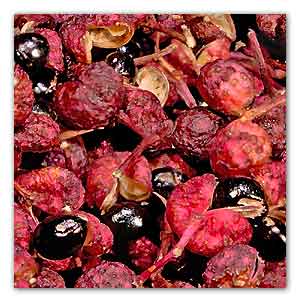News and Insights for
your best life. Online since 1998
- Home Health
- Breaking news
- In caso di...
- Per saperne di
più... - Medicina occidentale
- Medicine complementari
- Medicina cinese
e agopuntura - Omeopatia
- Fitoterapia

A tingling sensation caused by Asian spice could help patients with chronic pain. The science behind the tingling sensation has been explained by researchers at UCL.
The study, which is published today in the journal Proceedings of the Royal Society B, helps shed light on the complex interactions between the senses of taste and touch, and could lead to a greater understanding of the causes of the tingling sensations experienced by many chronic pain patients.

Zanthoxylum piperitum, Zanthoxylum simulans
Widely used in Asian cooking, the Szechuan pepper was found to mimic the sense of touch in the brain. After Szechuan pepper was applied to the lips of volunteers, participants were asked to match the frequency of the resulting tingling sensation by adjusting a vibrating stimulus, either higher or lower, on their fingertips.
The team was able to show that an active ingredient in the peppers stimulates specific RA1 fibres in the lips and tongue. These fibres are responsible for transmitting touch sensation, and send the equivalent of a light tap on the skin to the brain at the rate of 50 times per second.
Dr Nobuhiro Hagura (UCL Institute of Cognitive Neuroscience), lead author of the study, said: “What we found was that a unique active ingredient in the pepper, called sanshool, activates these fibres, sending a highly specific signal to the brain. Szechuan peppers and physical touch sensations share this same pathway to the brain...This is the first time that we’ve been able to show how chemicals activate touch fibres, inducing a measurable frequency. We know that natural products like chilli, mustard oil and menthol can activate the thermal and pain fibres in the skin, but we wanted to find out why Szechuan pepper specifically works on the light-touch fibres, producing a conscious sensation of touch and that distinctive tingling feeling...We hope that laboratory studies of the tingling sensations caused by sanshool could help to clarify the brain processes underlying these sensations, and how they are related to pain in some cases."
Scientists are also looking more at what constitutes touch, in hopes of restoring this sense in individuals suffering from paralysis or in people with nerve-related chronic pain like carpal tunnel syndrome or diabetic neuropathy. It could be that only minimal select activation of particular nerve fibres would be sufficient for the person to feel again.
Researchers are also investigating how touch sensations might improve dining experiences. He suspects that the pepper-caused tingle helps to boost flavour, causing the brain to pay more attention to other ingredients present in the dish.
The team also hopes to investigate the reasons why people enjoy eating Szechuan pepper and how touch sensation can boost the taste of food.
For more information
The study
Food vibrations: Asian spice sets lips trembling
California Department of Food and Agriculture
MDN
del Dott. Turetta
Quali sono i problemi o le disfunzioni che possono giovarsi di un intervento omeopatico d'urgenza e, di conseguenza, come dovrebbe essere un ideale armadietto medicinale omeopatico casalingo.- Home -
- Health -
- Depressione -
- Sexuality
- Environment -
- Food -
- Musica -
- Capirsi -
- Grafologia -
- Ridere
Copyright © 1998/2018 www.mybestlife.com tutti i diritti sono riservati eccetto quelli già di altri proprietari.
.In caso di
Pubblicità
Per saperne di più su
Pubblicità
Pubblicità
Pubblicità
Pubblicità


